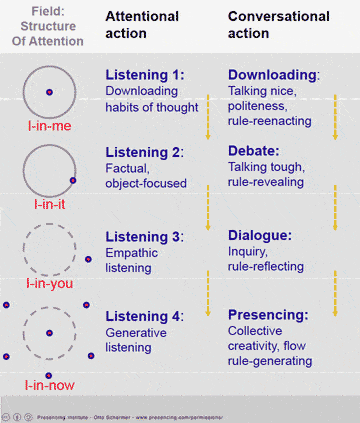If you’ve seen my book, you know my approach to successful change and leadership: I recommend to include and engage all employees and make change personal, practical and focused on behaviors in circles of 10 coworkers.
To help people reach consensus on the “What” to Change, I often start with the Organizational Culture Assessment Instrument (OCAI - developed by Cameron and Quinn) that quickly maps culture. Next, we organize workshops or circles to hold a dialogue about the “What” but especially about the “How” to Change. We discover the typical beliefs and behaviors that make up current culture and we engage in the puzzle of how to change our daily habits to help the system change toward the preferred culture and desired results.
In this approach everyone is included and co-creates their team’s plan of how to change. We focus on Doing it (not just talk about it) and on Persistence (keep doing the new actions) because coworkers support each other in the change circle. The circle is a structure that helps people change and persist over time – thus contributing to successful change. Everyone takes ownership for their personal change aligned with the collective change or learning.
A successful change circle is based on dialogue techniques: together, we create a space where it is safe to speak up so information starts to flow freely and new meanings and actions emerge and can be nurtured and practiced. It is like an incubation circle: the first small, safe bubble of a new culture, where we practice new behaviors and new ways of performing. That is, if the conditions for dialogue and inclusion are met...
Creative, Connecting Dialogue
The space must be made safe, initiated by the facilitator and supported by the group. Everyone is equal within the group and all contributions are welcomed – even when they deviate from expectations or group norms. Everyone gets “air time” – so the extroverts don’t run the show. We practice respect for different viewpoints and try to build on shared goals and similarities rather than our differences. Only when these conditions are established, we are likely to create change that will make a difference.
An OCAI culture workshop or change circle is a way to develop the organization. It is a practice to learn together and become “change-proof” for the future in small teams by developing collaboration skills, starting with true conversation. Organizational success is defined by the number of conversations taking place, but above all by the quality of those conversations. To fully benefit from the change circles, we lift people to a creative and connecting dialogue.
In his book Theory U: Leading from the Future as It Emerges, Otto Sharmer discerns 4 levels of conversation in organizations. The first 3 are easy to recognize and relevant to our culture workshops or change circles:
The first 3 are easy to recognize and relevant to our culture workshops or change circles:
1. Downloading: Talking nice, politeness, rule-reenacting.
This is the well-know way of meetings where people don’t speak their mind and say “yes” while they mean “no – or maybe”. It is about conformity to the dominant group culture. “Silence” is a way to fit in and be safe, even when you don’t completely agree. This is not the way to reach true consensus.
2. Discussion: Talking tough, rule revealing.
This is debate to win the argument. Egos speak and focus on differences and winning and losing. Dominant views may be pushed, other views may be ridiculed, differences are revealed and rules are revealed (Who is the boss? Who gets air time? What gets buy-in?). Debate shows more energy and awareness than Downloading and is more creative – but the way it is done (from Egos, agendas and fights) is not creating a safe space and biased by air time for extroverts. “Violence” (pushing your opinions and logic) is a way to fit in into this group culture, even when you don’t completely agree with the final outcome. This is not the way to reach true consensus.
3. Dialogue: Inquiry and Rule-reflecting.
This is a constructive conversation based on equality and respect. It departs from true interest in other’s view point and inquiry. “How come…?” Rules are reflected upon. Thinking out-loud together occurs. Everyone contributes equally to “the pool of meaning in the middle”. Information starts to flow and collective intelligence emerges. We’re looking for common intent and goals, shared meanings and emerging actions that the group will take ownership for.
This is the way to reach true consensus: if people say “yes” they mean it and will commit themselves to the plan. This is what we try to accomplish when facilitating change circles – but it requires inner work of the participants and a willingness to open up and let go of fears, prejudice and old habits...
In my next blog, I’ll show you a case of an organization that practiced dialogue techniques prior to working in change circles...!
Marcella Bremer MScBA